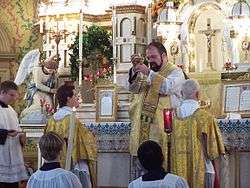
Liturgy
Liturgy (Greek: λειτουργία) is the customary public worship performed by a specific religious group, according to its particular beliefs, customs and traditions.
The word, sometimes rendered by its English translation "service", may refer to an elaborate formal ritual such as the Eastern Orthodox Divine Liturgy (Greek: Θεία Λειτουργία), Catholic Mass, the Eucharist or Mass (Anglican Communion) or a daily activity such as the Muslim salah and Jewish services. As a religious phenomenon, liturgy is a communal response to the sacred through activity reflecting praise, thanksgiving, supplication, or repentance. Ritualization may be associated with life events such as birth, coming of age, marriage and death. It thus forms the basis for establishing a relationship with a divine agency, as well as with other participants in the liturgy. Methods of dress, preparation of food, application of cosmetics or other hygienic practices are all considered liturgical activities.
Etymology
The word liturgy, derived from the technical term in ancient Greek, leitourgia, signifies the often expensive offers of service to the people, and thus to the polis and the state. Through the leitourgia, the rich carried a financial burden and were correspondingly rewarded with honours. The leitourgia became both mandatory and honorific, supporting the patron's standing among the elite. The holder of a Hellenic leitourgia was not taxed a specific sum, but was entrusted with a particular ritual, which could be performed with greater or lesser magnificence. The chief sphere remained that of civic religion, embodied in the festivals: M.I. Finley notes "in Demosthenes' day there were at least 97 liturgical appointments in Athens for the festivals, rising to 118 in a (quadrennial) Panathenaic year." Eventually, under the Roman Empire, such obligations, known as munera, devolved into a competitive and ruinously expensive burden that was avoided when possible.
Liturgy (disambiguation)
Liturgy is a Christian term with several meanings:
Liturgy may also refer to:

Eucharist in the Catholic Church
The Eucharist in the Catholic Church is the celebration of Mass, the eucharistic liturgy. The term Eucharist is also used for the bread and wine when transubstantiated (their substance having been changed), according to Catholic teaching, into the body and blood of Jesus Christ
Blessed Sacrament is a devotional term used in the Roman Catholic Church to refer to the eucharistic species (the Body and Blood of Christ). Consecrated hosts are kept in a tabernacle after Mass, so that the Blessed Sacrament can be brought to the sick and dying outside the time of Mass. This makes possible also the practice of eucharistic adoration.
New Testament foundations
The First Eucharist in Scripture
The Catholic Church sees as the main basis for this belief the words of Jesus himself at his Last Supper: the Synoptic Gospels (Matthew 26-28; Mark 14:22-24; Luke 22:19-20) and Saint Paul's 1 Corinthians 11:23-25 recount that in that context Jesus said of what to all appearances were bread and wine: "This is my body … this is my blood." The Catholic understanding of these words, from the Patristic authors onward, has emphasized their roots in the covenantal history of the Old Testament.
Harmonia
Harmonia may refer to:
Antiquity
Art
Astronomy and geography
Biology
Music
Albums
Songs

Harmonia (Gelo)
Harmonia was a young Sicilian woman who was the daughter of Gelo, the son of King Hiero II of Syracuse. She was the wife of Themistius.
Ancient history records that one day the people of Syracuse rebelled against the royal family. The young king Hiero was murdered along with Themistius and Andronodorus, sons-in-law of Gelo and Hiero. The angry crowd then murdered the wives of Themistius and Andronodorus. Then with drawn swords they attacked the daughters of Hiero, Damarata and Heraclia, killing them both. They then went looking for Harmonia to finish their deeds. With the clever thinking on the part of Harmonia's nurse and protector, she found a girl that was of the same age and looks of Harmonia that was willing to go along with a ruse to protect the life of Harmonia. The nurse dressed her up in royal attire and made ready for the assassins. The girl did not object to the stratagem and was more than willing to sacrifice her life for the royal family princess. When the assassins saw her they quickly finished her off with their daggers and swords. Harmonia watching the murder take place from her safe hiding place had mixed emotions of the event. She was elated by the courage of the girl, but devastated by her death. Harmonia burst into tears and committed suicide.

Harmonia (sculpture)
Harmonia (Finnish) or Harmoni (Swedish, "Harmony") is a fountain sculpture by Achim Kühn. It is located in the Aura River in Turku, Finland.
External links
References
Coordinates: 60°26′21.2″N 22°14′36.2″E / 60.439222°N 22.243389°E / 60.439222; 22.243389
Podcasts:

